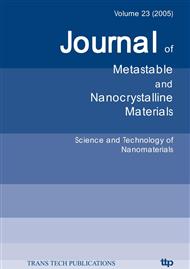[1]
S. Ikegami, I. Ueda, Piezoelectricity in Ceramics of Ferroelectric Bismuth Compound with Layer Structure, Jap. J. Appl. Phys., 13, 1572-1577, (1974).
DOI: 10.1143/jjap.13.1572
Google Scholar
[2]
T. Takenaka, K. Sakata, Grain Orientation Effects on Electrical Properties of Bismuth Layerstructured Ferroelectric Pb(1-x)(NaCe)x/2Bi4Ti4O15 Solid Solution, J. Appl. Phys., 55, 1092- 1099, (1984).
DOI: 10.1063/1.333198
Google Scholar
[3]
I.G. Ismailzade, V.I. Nesterenko, A Method for Finding the Curie Temperature and Measuring the Temperature Dependence of the Dielectric Susceptibilty of Ferroelectric and Antiferroelectrics with High Electrical Conductivity, Sov. Phys. Chrytallogr., 12, 625-626, (1968).
Google Scholar
[4]
P.S. Rama Sastry, T. Bhimasankaram, G.S. Kumar, G. Prasad, S.V. Suryanarayana, Dielectric Studies of Layer Structured Sodium-Calcium Bismuth Titanate Mixed Ceramics, Indian J. Eng. Mater. Sci., 5, 83-87, (1998).
DOI: 10.1007/bf02745676
Google Scholar
[5]
M. Kimura, T. Sawada, A. Ando, Y. Sakabe, Energy Trapping Characteristics of Bismuth Compound CaBi4Ti4O15, Jap. J. Appl. Phys., 38, 5557-5560, (1999).
DOI: 10.1143/jjap.38.5557
Google Scholar
[6]
H.X. Yan, C.E. Li, J.G. Zhou, W.M. Zhu, L.X. He, L.X. Song, A-site (Mce) Substitution Effects on the Structures and Properties of CaBi4Ti4O15 Ceramics, Jap. J. Appl. Phys., 39, 6339-6342, (2000).
DOI: 10.1143/jjap.39.6339
Google Scholar
[7]
L. Nibou, A. Aftati, M. El Farissi, J.P. Mercurio, Chemical Fabrication SrBi4Ti4O15 Thin Films, J. Eur. Ceram. Soc., 19, 1383-1386, (1999).
DOI: 10.1016/s0955-2219(98)00441-5
Google Scholar
[8]
J.S. Benjamin, Mechanical Alloying, Sci. Amer., 234, 40-48, (1976).
Google Scholar
[9]
J. Ding, W.F. Miao, P.G. McCormick, R. Street, Mechanochemical Synthesis of Ultrafine Fe Powder, Appl. Phys. Lett., 67, 3804-3806, (1995).
DOI: 10.1063/1.115389
Google Scholar
[10]
A.K. Giri, Nanocrystalline Materials Prepared through Crystallisation by Ball Milling, Adv. Mater., 9, 163-166, (1997).
DOI: 10.1002/adma.19970090216
Google Scholar
[11]
J.M. Xue, J. Wang, D.M. Wan, Nanosized Barium Titanate Powder by Mechanical Activation, J. Am. Ceram. Soc., 83, 232-234, (2000).
DOI: 10.1111/j.1151-2916.2000.tb01179.x
Google Scholar
[12]
J. Wang, J.M. Xue, D.M. Wan, W.B. Ng, Mechanically Synthesized Lead Magnesium Niobate, J. Am. Ceram. Soc., 82, 1358-1360, (1999).
Google Scholar
[13]
J. Wang, D.M. Wan, J.M. Xue, Synthesising Nanocrystalline Pb(Zn1/3Nb2/3)O3 Powders from Mixed Oxides, J. Am. Ceram. Soc., 82, 477-479, (1999).
DOI: 10.1111/j.1551-2916.1999.tb20091.x
Google Scholar
[14]
J.M. Xue, D.M. Wan, S.E. Lee, J. Wang, Mechanochemical Synthesis of Lead Zirconate Titanate from Mixed Oxides, J. Am. Ceram. Soc., 82, 1687-1692, (1999).
DOI: 10.1111/j.1151-2916.1999.tb01987.x
Google Scholar
[15]
S.E. Lee, J.M. Xue, D.M. Wan, J. Wang, Effects of Mechanical Activation on the Sintering and Dielectric Properties of Oxide-derived PZT, Acta. Mater., 47, 2633, (1999).
DOI: 10.1016/s1359-6454(99)00141-x
Google Scholar


